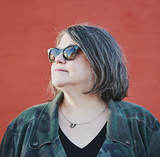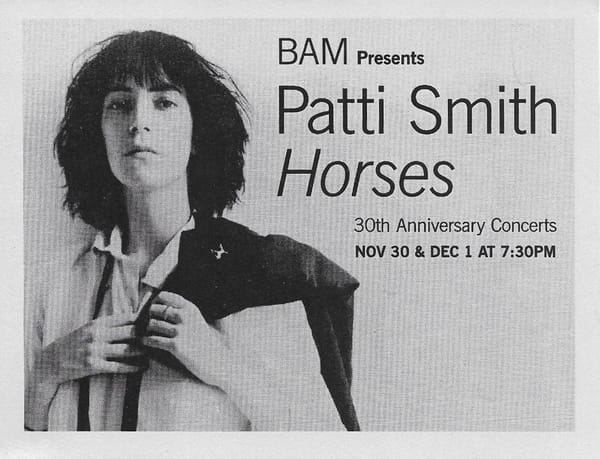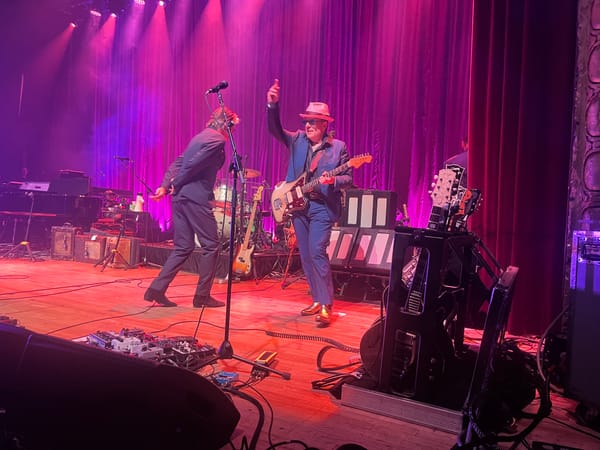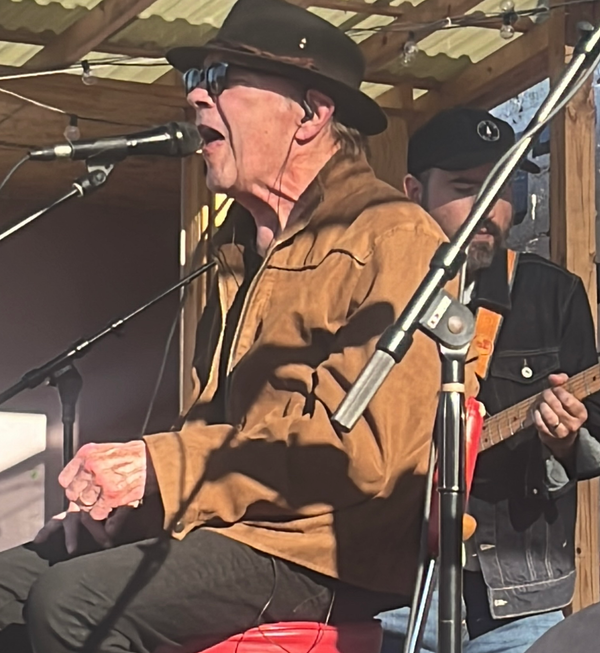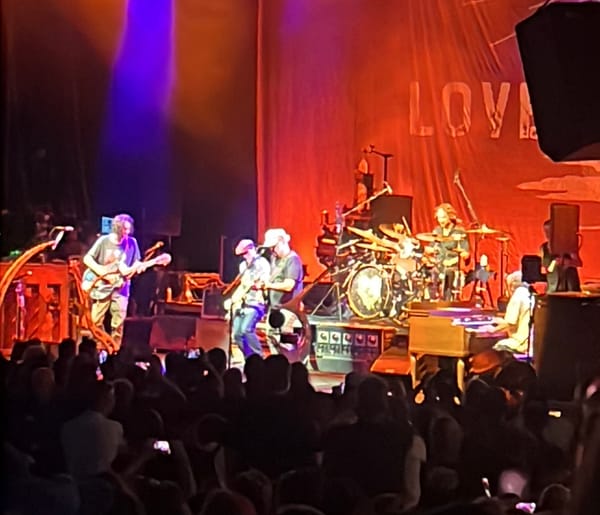pilgrimage: Visiting Kent State
in honor of Allison Krause, Jeffrey Miller, Sandra Scheuer and William Schroeder
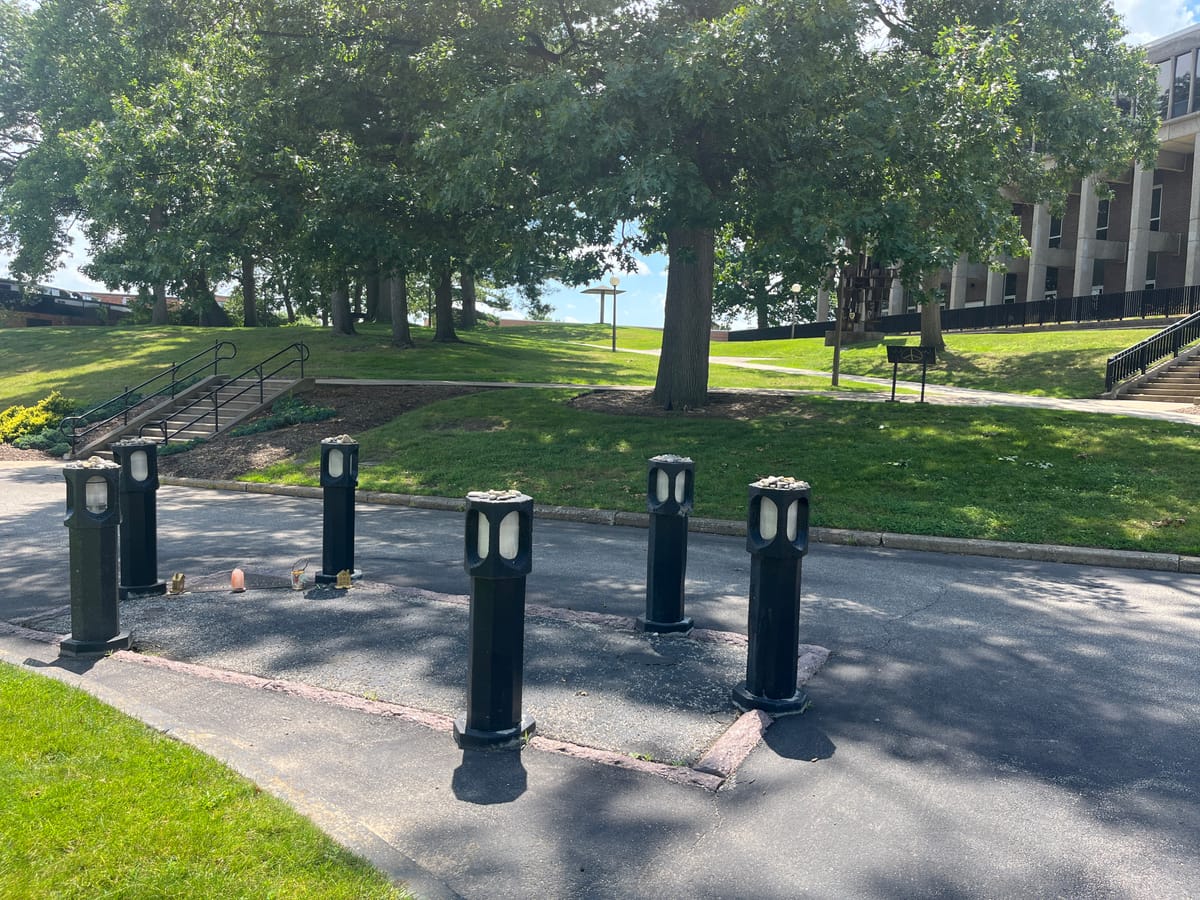
It’s easy to forget, or maybe not realize, that the four students murdered at Kent State University on May 4, 1970, were shot in a parking lot. That the National Guard didn’t shoot into the large crowd of protestors gathered on the Commons, but instead, knelt, aimed, and fired on students that were in some cases hundreds of feet away. The families of the dead students asked the university to keep that parking lot a parking lot, so if you decide to go to Kent State and visit the May 4th Visitors Center, that’s where you park. There are two signed and reserved spaces for the visitor’s center in a lot that is used every day, like any parking lot on any university campus.
I had a warning about all of this before I got there, and it did not help. It already felt like my already-pounding heart was just starting to climb from my chest into my throat as I turned onto campus. Once I pulled into the parking lot, it beelined up my body for safety, settling at the base of my neck, a giant lump of energy that was going to stop me from screaming out loud, probably because I’m not sure I would have known how to stop it. I pulled into a space, put the car in park, turned off the ignition, and opened the door without pausing for a breath. This was a mistake, because I was not ready. I was not ready for the visceral discomfort as soon as my foot hit the pavement.
That’s because the memorial essentially begins right there on the blacktop. It was a parking lot then and it’s a parking lot now. The spaces where the murdered students fell are edged by bollards and concrete but they’re right there amidst the other working parking spaces. It doesn’t matter how much you have read about Kent State or how many photographs you have seen, being in the actual place it happened is always profound.
The four spaces are illuminated at night.
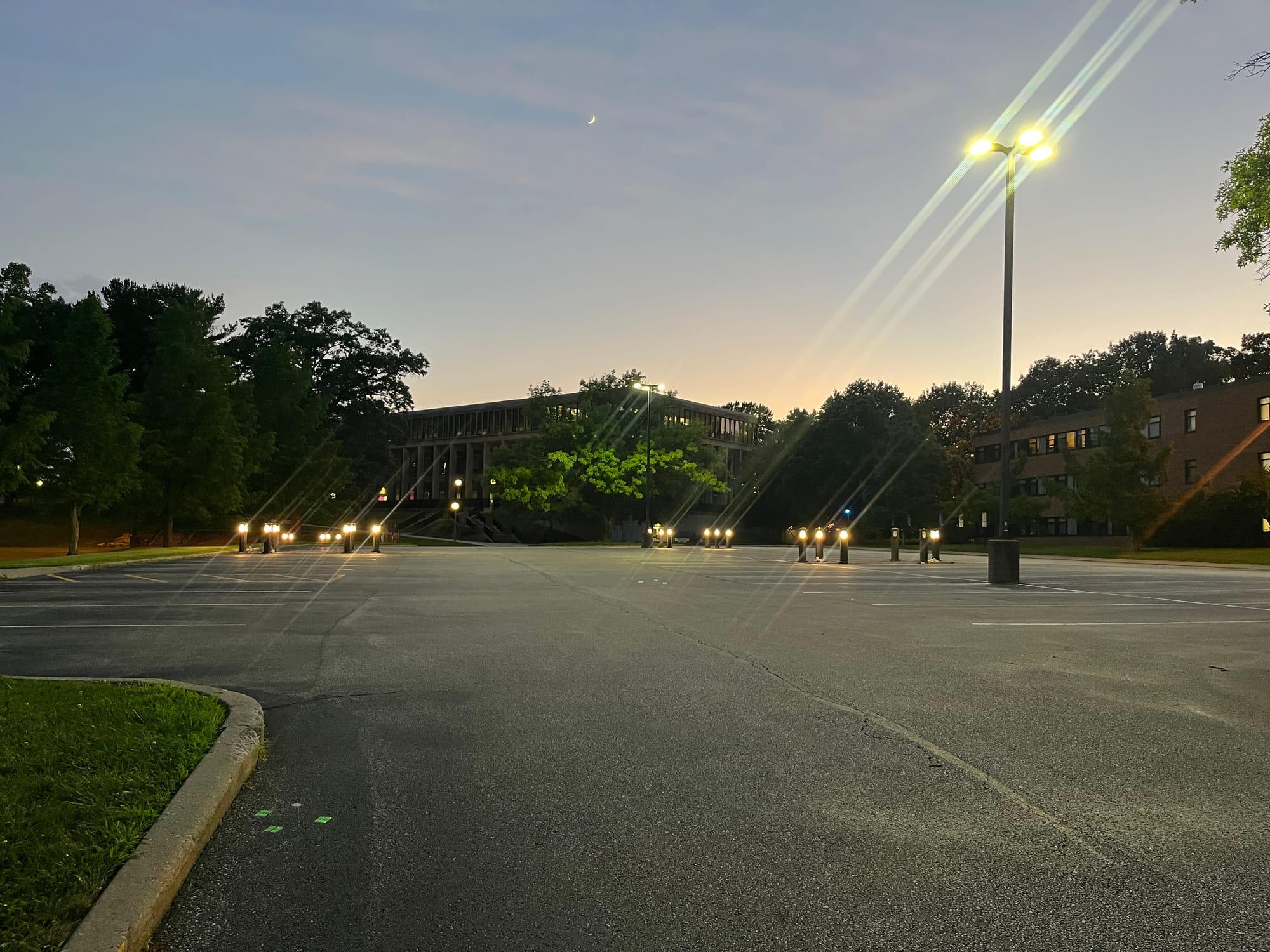
I was in Akron in July to go to a wedding reception. I am pathologically unable to go on a trip somewhere without doing sufficient research to ensure I am taking advantage of anything interesting in the immediate vicinity. In the process of trip planning, the mundane task of figuring out which hotel location made the most sense, I zoomed out on the map and realized I would be the closest I have been to Kent State since I moved to the Midwest.
You have to realize that Kent State is a place I have thought about since I was a small child because I have actual memories of hearing the news of the murders on television. Its proximity has been on my mind since I decamped to the Midwest. A normal person would think, “I’m coming here for a happy occasion, perhaps this is not a good side quest for this particular trip.” The fact that I left the reception and thought, “I should go back and see the memorials at night” is just how my brain works.
In the course of planning, I realize that I am internet-friends with the director of the May 4th Visitor’s Center, and she kindly offers to come in on her day off and show me around. The visitor's center is small but well-curated, and if you are someone who cares enough to come and be a witness or pay your respects, I absolutely recommend it. But you do not need to limit yourself to coming here when the museum is open, because it all happened outside, and there are informative plaques and QR codes and just situating the physical landscape with the images in your brain is going to be incredibly profound.
Again, you drive into the parking lot and are confronted by the memorials to the dead as well as the markers for the injured. That’s where you’re starting. Then you can walk up the hillside and see the plaque in the ground for the line of fire; you can see a bullet hole in a metal sculpture adjacent; you can turn and see the Commons where some students decided that their response to Nixon’s escalation into Cambodia was to bury the Constitution, because the students were disgusted.
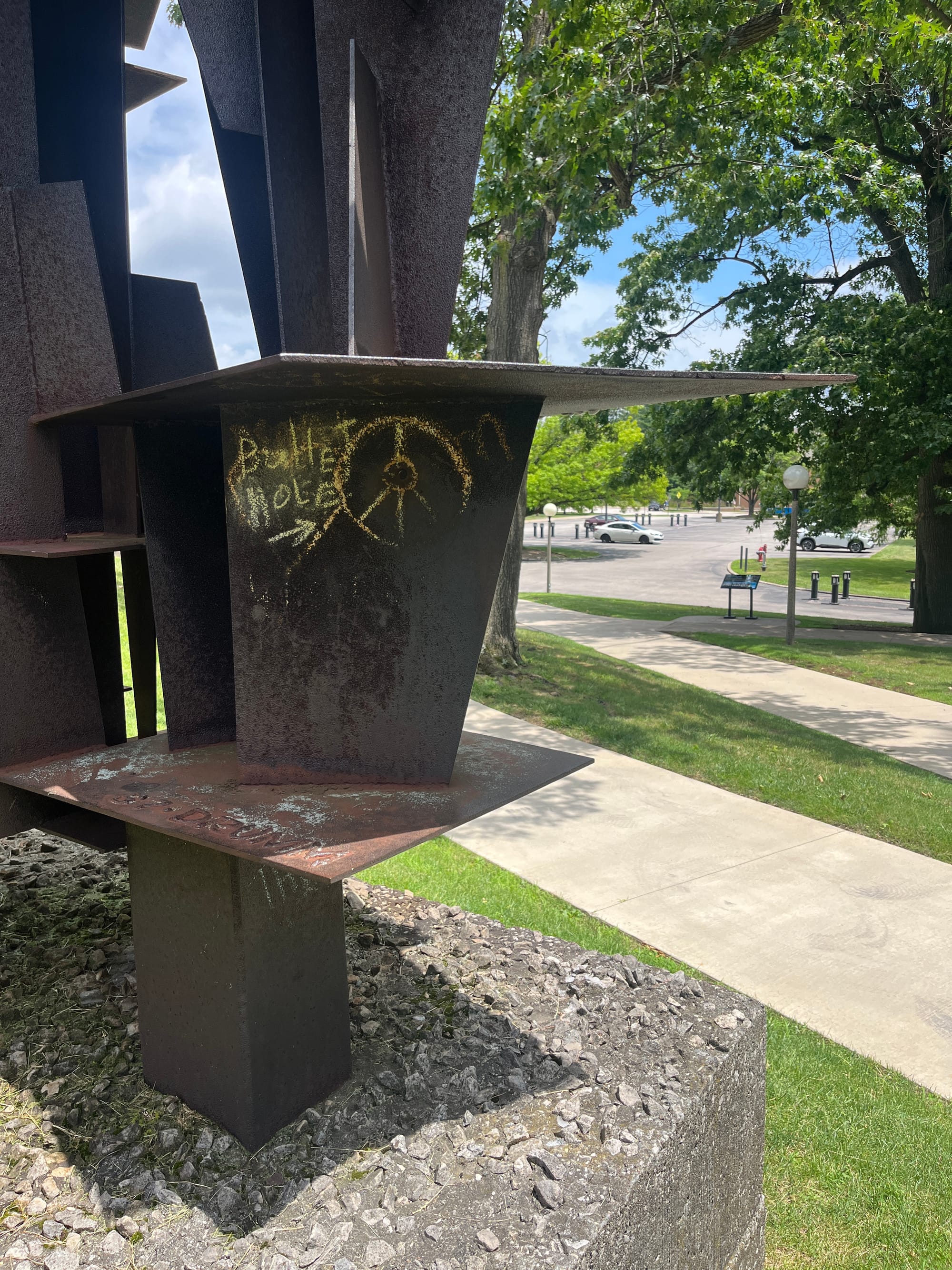
This is why the National Guard was called. That is why they shot at that small group of students in the parking lot. I know it is more than that, but if we are looking at empirical evidence, at facts, no one was shooting at the National Guard. If hundreds of armed troops were endangered by a couple of hundred college students, then those troops aren’t very good at their job.
That is a statement that is equally true right now.
Being resentful of young people who thought the war was wrong is a thought, it isn’t a threat. Being angry that they have long hair and get to go to college and not think about adult life for four years is a feeling, it is not menace.
There’s been a lot of discussion over the years within the people who are still thinking about Kent State about whether there was an actual order to fire. I don’t know that I have an opinion on that (it would require an enormous amount of research and I can’t do that to myself) but at least an order to fire would have been a cause, a reason, another fact. The idea that these troops hated the students so much that they’d just fire without an order is worse. But I am also writing this in 2025 and when I originally wrote it a month ago, we were just facing the initial National Guard insurgence into Los Angeles because some people waved Mexican flags and blocked a highway because their friends and family and neighbors were being disappeared by masked thugs.
It is clearly not that hard to hold that much hate, not that there aren’t countless other events in history -- both ancient and very modern -- that prove that true over and over again.
I also remind myself that most of America -- 58% -- blamed the students for what happened at Kent State; I knew it was a large number but that is a data point the visitor’s center helpfully provided. That the feeling or the appearance of being something outside of what someone considered to be normal and accepted reality was enough justification to be murdered by the state.
My friend walked me around the grounds, which I was grateful for because I was overwhelmed and also, there is nothing I appreciate more than hearing an expert hold forth on their particular area of expertise. She opened up the visitor’s center for me and then explained a million more things I wouldn’t have even known to ask. When I was finished, I thanked my host for her incredible generosity, and then walked the grounds again by myself. It wasn’t any easier but it felt even more essential. I wanted to be aware and conscious that I was standing on the very same ground as Alison Krause, Jeffery Miller, Sandy Scheuer and William Shroeder walked on and were then murdered on.
There are so many photographs that we have seen over the years, and now that I am here, they all click into place. You are now inside the frame. The terrain has not changed; the hills are still the hills, the slopes were slopes, the trees have grown taller and there’s tall grass on the incline leading up from the Commons to Taylor Hall. There are newer buildings; there is a gymnasium that was eventually built on the location where an injured student fell, but I think I did not expect this location to be so intact. You would think that the powers that be would have bulldozed the entire area down to bedrock if they could have. Among all the other emotions I am carrying is respect for everyone who fought to make sure that this day and these people wouldn’t just get buried under time and paperwork.
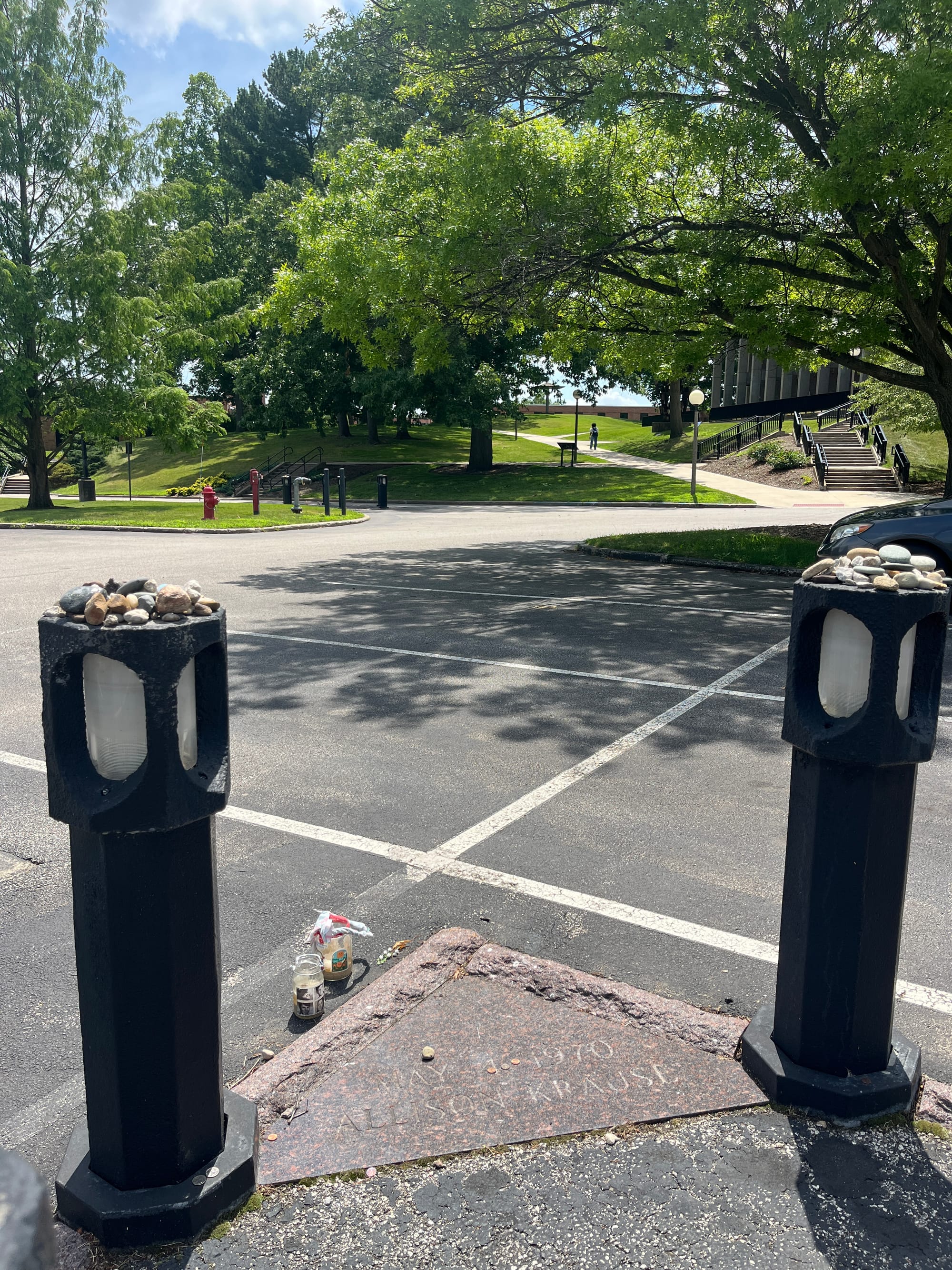
I believe that the land holds energy, that places have a memory of what has happened there. I walked between each of the parking lot memorials, stopping each time to look back at the hill where the National Guard was standing when they fired. Each of the bollards is covered in small pebbles, and out of instinct I stoop down to pick up some rocks to add to the tribute. This isn’t a random gesture – three of the four murder victims were Jewish, a fact I only learned for the first time today – and the first memorial at the site was erected by B’nai Brith, the predecessor of Hillel on campus. The energy of the place is absolutely uneasy. I try to stand there long enough to settle into it and to not cave to my body’s very physical response to flee the area as fast as I can. It seems like the least I could possibly do.

It is not just what happened on May 4th, it is everything that happened afterwards as well, the endless ongoing fights for justice.
They know the names of every person who fired live ammunition that day. They were found not guilty, although they all signed a statement acknowledging responsibility. That is also in the visitor's center.
But also? 58%.
When I came back after the reception I parked on the edge of the lot, because I was honestly too shook up to venture further. The individual memorial spaces are new; they were only erected in 1999. Every year, a vigil is held where someone physically stands at each marker and there is a special candleholder that is used year after year. They stay there all night until 12:24pm, the time that the shots were fired. That is beyond profound. It is the kind of gesture America does not like. It is ever-present, it does not diminish, it does not slink over to the sidelines where it won’t bother anyone. It is a legacy, it is holy in a way that we as a society have rejected. These kids were murdered by the state and their memories and where they died and why they died and how they died is on display in the wide open, still, over 50 years later.
There are also markers for every student who was shot and injured, but not killed. These were only installed a few years ago. The markers have their name and the distance they stood from the assembled National Guard up on the hill. They are embedded in the blacktop, into the ground, wherever that student was standing at the time.

And all of this only happened because of the people who made it happen. Every family member, every student, every community member, every faculty member, every person who comes here, stands here, walks around here. While I was walking around on my own, I observed multiple groups of people walking from plaque to plaque, phones in hand. The director told me that people drive by the sign on the highway and think, “Oh, Kent State,” and find their way to the memorial. When I was walking around paying my respects, cars would pull into the parking lot and small groups would get out, phones in hand. And there were also students. Kent State is on a trimester system, so there were kids walking from building to building, talking to their friends and eating popsicles. Two were playing a game of catch on the field that was the former Commons.
There’s that meme that goes around the internet: “What radicalized you???” and it’s meant as a joke, mostly; it’s people posting about $12 bottles of ketchup or some other perceived indignity which is never actually a big deal. But on the drive down to Ohio, for the first time I began to put the puzzle pieces together for myself. I grew up watching the evening news in the late 60s and remember hearing the body count numbers from Vietnam, and somehow understanding what that meant. I was in elementary school and my parents probably shouldn’t have let us watch the news but it was the 70s and no one thought about whether or not to let your children be exposed to current events.
In 3rd or 4th grade, I asked my parents if I could have a POW bracelet. My father’s response was to ask me what that was and why I wanted one. I don’t remember what I said, but apparently I answered to my father’s satisfaction and my bracelet arrived in the mail. I wore it to school where I wasn’t the only girl (it was only girls) wearing one. My dad and I would go through the newspaper when they posted the names of the soldiers coming home from Vietnam, looking for my POW; we did this for years but never saw his name. At some point, I lost track of the bracelet, I went off to college and boxes of stuff got consolidated and moved and then it was gone.
My mom taught me to read when I was very, very young; she explained later that it was because she didn’t know what else to do with me to keep me busy. In her defense, this probably happened after my brother, two years younger than me, arrived prematurely, along with a twin brother who didn’t make it. My brother was in the NICU for what seemed to a child to be a long time, and I could spend the entire day lying on the grass or hiding behind the couch, reading a book.
The other thing that I remember from this time period was that my father subscribed to the New York Times, but since we lived outside of Baltimore, the paper arrived in the late afternoon. It was my job to go down to the end of what seemed like an incredibly long driveway down a very steep hill and collect the newspaper, and by the time I got to the house I needed to be able to tell my father about one of the stories on the front page of the newspaper. I was four and probably did not need to know about the My Lai massacre, but I remember going to the big dictionary on the heavy wooden stand and thumbing through M. (In our house you did not ask what a word meant, you looked it up.)
I remember seeing the reports about Kent State on the news. I remember my father being upset, him telling me, “They were just kids.” That, of course, did not help this kid, but I didn’t worry about me, I worried instead about the handful of teenagers who rotated through as babysitters. They looked like the kids I saw on the news.
So when I got older it should not have surprised anyone when I decided to do my junior year history paper on the Chicago 7, or how when it came time to apply to colleges, I wanted to go to Berkeley. Or how the first time I walked onto the Columbia University campus for a student journalist conference in high school, I was impressed for very different reasons than my classmates (and of course have a whole different set of emotions now, but this essay is not about the American institutions of higher learning obeying in advance).
And so it makes absolute sense that I went to Kent State to pay my long-overdue respects on the way to a wedding. In 2024, I got to see Neil Young sing “Ohio” at the New Orleans Jazz and Heritage Festival, and in August of 2025, I got to listen to Neil sing it one more time, this time fully charged with an entire band. I stood up and closed my eyes and tried not to collapse into helplessness. Let this continue to radicalize you. Pay witness. Visit the places. Retell the stories. Be annoying. Be relentless. It all matters.

